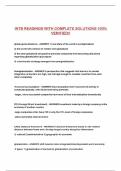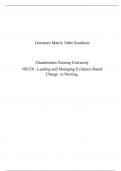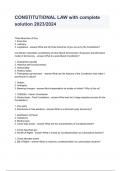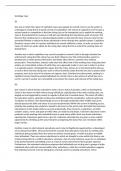How do both writers present Science and Technology?
Writing in the decadent atmosphere of the 1890s, both Wilde and Stoker rejuvenate
traditional Gothic figures: the doppelganger and the vampire in order to explore fin-de-siecle
anxieties around degeneration, social instability and the rise of scientific rationalism. Both
writers present science and technology as a modern force that holds a lot of power in
Victorian society. Whilst Stoker presents Science and Technology with a sense of optimism
characteristic of the theory of scientism, as a response to the idea of degeneration in the fin
de siecle period, which is seen through his use of science for the good, Wilde portrays
science and technology as a destructive force of evil, possibly suggesting his mode of
pessimism towards the hyper industrialisation of Britain and the move towards modernity at
the turn of the century. In ‘Dorian Gray’, Wilde focuses on the explicit chemical destruction of
dead bodies, the subtle aestheticised perversion of Lombroso’s physiognomy and the
implicit, evil psychological studies placed on the protagonist of the novel; whereas in
‘Dracula’, Stoker turns to scientism to explore graphic descriptions of science for good
through the use of blood transfusions, as well as the use of an epistolary form to document
the psychological progress of mental patient Renfield, and the vivid descriptions of
Lombroso’s physiognomy in Dracula’s appearance.
In Chapter two of ‘Dorian Gray, Oscar Wilde defies Lombroso’s theory of Physiognomy in his
appearance of Dorian Gray. To rebel against Lombroso’s theory of physiognomy, Wilde uses
the rising action of the novel to employ irony which is used to describe a typically villainous
character as beautiful. This defiance is achieved when Wilde writes ‘‘There was something in
his face that made one trust him at once’. Wilde’s use of hyperbolic language to emphasise
the trusting nature of Gray is deceitful as the protagonist ends up developing into a
monstrous villain, who appears to only be interested in the opulent lifestyle of decadence,
which the fin de siecle period characterised. In defying Lombroso’s theory, and perversely
foreshadowing Dorian’s downfall, whilst rejecting science in portraying an evil character as
beautiful, Wilde creates scepticism about the science of appearance, insinuating that it is not
useful, but potentially misleading, which would create a sense of pessimism for the Victorian
reader and their perception of science. Whereas, whilst Wilde perverts the idea of
physiognomy and insinuates its lack of effect, in the introductory Chapter two of ‘Dracula’,
written in the epistolic form of Harker’s diary to convey the ordinary British man’s thoughts,
Stoker uses a British imperialist stance to introduce Dracula as corrupt through his
appearance. It is evident that Stoker uses Lombroso’s theory of physiognomy as a potential
warning sign to foreshadow Dracula’s evil nature when he writes ‘‘His eyebrows were very
massive, almost meeting over the nose’ and later ‘Was fixed and rather cruel-looking, with
peculiarly sharp white teeth’. In the use of descriptive language of the typical gothic trope of
a vampire to create an image of a monstrous supernatural forces, Stoker complies with the
fin de siecle fears of degeneration and moreover, by describing its citizens in a
dehumanising tone, Stoker potentially implies a further fear of the east as a result of the
decline of the British Empire. Therefore,through the characterisation of Dracula, Stoker is
able to present Lombroso’s physiognomy as a useful technique for identifying danger.
Stoker’s use of scientism as a response to fears of degeneration in Victorian Society is
further evident in the ‘novel’ Dracula when he uses the epistolary form to include diary
extracts from Doctor Seward concerning his mental patient, Renfield. Throughout the novel,
the development of Renfield’s mental illness is portrayed through the eyes of Seward,
Writing in the decadent atmosphere of the 1890s, both Wilde and Stoker rejuvenate
traditional Gothic figures: the doppelganger and the vampire in order to explore fin-de-siecle
anxieties around degeneration, social instability and the rise of scientific rationalism. Both
writers present science and technology as a modern force that holds a lot of power in
Victorian society. Whilst Stoker presents Science and Technology with a sense of optimism
characteristic of the theory of scientism, as a response to the idea of degeneration in the fin
de siecle period, which is seen through his use of science for the good, Wilde portrays
science and technology as a destructive force of evil, possibly suggesting his mode of
pessimism towards the hyper industrialisation of Britain and the move towards modernity at
the turn of the century. In ‘Dorian Gray’, Wilde focuses on the explicit chemical destruction of
dead bodies, the subtle aestheticised perversion of Lombroso’s physiognomy and the
implicit, evil psychological studies placed on the protagonist of the novel; whereas in
‘Dracula’, Stoker turns to scientism to explore graphic descriptions of science for good
through the use of blood transfusions, as well as the use of an epistolary form to document
the psychological progress of mental patient Renfield, and the vivid descriptions of
Lombroso’s physiognomy in Dracula’s appearance.
In Chapter two of ‘Dorian Gray, Oscar Wilde defies Lombroso’s theory of Physiognomy in his
appearance of Dorian Gray. To rebel against Lombroso’s theory of physiognomy, Wilde uses
the rising action of the novel to employ irony which is used to describe a typically villainous
character as beautiful. This defiance is achieved when Wilde writes ‘‘There was something in
his face that made one trust him at once’. Wilde’s use of hyperbolic language to emphasise
the trusting nature of Gray is deceitful as the protagonist ends up developing into a
monstrous villain, who appears to only be interested in the opulent lifestyle of decadence,
which the fin de siecle period characterised. In defying Lombroso’s theory, and perversely
foreshadowing Dorian’s downfall, whilst rejecting science in portraying an evil character as
beautiful, Wilde creates scepticism about the science of appearance, insinuating that it is not
useful, but potentially misleading, which would create a sense of pessimism for the Victorian
reader and their perception of science. Whereas, whilst Wilde perverts the idea of
physiognomy and insinuates its lack of effect, in the introductory Chapter two of ‘Dracula’,
written in the epistolic form of Harker’s diary to convey the ordinary British man’s thoughts,
Stoker uses a British imperialist stance to introduce Dracula as corrupt through his
appearance. It is evident that Stoker uses Lombroso’s theory of physiognomy as a potential
warning sign to foreshadow Dracula’s evil nature when he writes ‘‘His eyebrows were very
massive, almost meeting over the nose’ and later ‘Was fixed and rather cruel-looking, with
peculiarly sharp white teeth’. In the use of descriptive language of the typical gothic trope of
a vampire to create an image of a monstrous supernatural forces, Stoker complies with the
fin de siecle fears of degeneration and moreover, by describing its citizens in a
dehumanising tone, Stoker potentially implies a further fear of the east as a result of the
decline of the British Empire. Therefore,through the characterisation of Dracula, Stoker is
able to present Lombroso’s physiognomy as a useful technique for identifying danger.
Stoker’s use of scientism as a response to fears of degeneration in Victorian Society is
further evident in the ‘novel’ Dracula when he uses the epistolary form to include diary
extracts from Doctor Seward concerning his mental patient, Renfield. Throughout the novel,
the development of Renfield’s mental illness is portrayed through the eyes of Seward,










